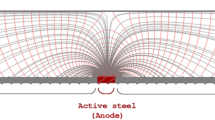Abstract
The monitoring of corrosion in reinforced concrete structures is considered an important preventive factor against the corrosive damage. The present paper shows the design and construction of a device which performs remote measurements of the polarization resistance of reinforcing steel, this was made using the electrochemical technique of linear polarization resistance as a method to obtain the information of the corrosive process. The development was carried out by implementing a potentiostat based on a free development platform. The design allows to store all the data on a physical memory and to send the results through the mobile network to a web server, where the measured values can be analyzed using an internet connection.
The linear polarization resistance measurements were made in cylindrical concrete specimens with rebars of ½ ”, each one instrumented with embedded electrodes of Copper/Copper sulfate and graphite. The specimens were subjected to a saturated environment of chlorides (3.5%) where the corrosive process was monitored with the developed system. The results were compared with tests performed on a commercial potentiostat / galvanostat, where the values obtained have an mean of 4.83%.
Similar content being viewed by others
References
Sadowski L., New non-destructive method for linear polarization resistance corrosion measurement, Archives of Civil and Mechanical Engineering 10 (2), 109–116, 2010.
Tang F, Chen G, Brow R., Volz J, Koenigstein M., Corrosion resistance and mechanism of steel rebar coated with three types of enamel. En: Corrosion. Science, volume 59, 57168, 2012
Broomfield John P., Davies Kevin, Hladky Karel, The use of permanent corrosion monitoring in new and, Cement & Concrete Composites, vol. 24, pp. 27–34, 2002.
Pradhan B, Bhattacharjee B. Performance evaluation of rebar in chloride contaminated concrete by corrosion rate. En: Construction and Building Materials, Volume 23, 23462356, 2009.
Mohan M. V. “12 – High-Volume Fly Ash and Slag Concrete”. Concrete Admixtures Handbook (Second Edition). pp. 800–838, 1996.
Ming T. L, Wenjun Q, and Chih-Hsin L. “Mathematical modeling and prediction method of concrete carbonation and its applications”. Journal of Marine Science and Technology, Vol. 10, No. 2, pp. 128–135, 2002.
Vazqueza D.R., b, Villagrán Zaccardic Y.A., d, Zegac C.J., d, Sosac M.E., d, Duffóa G.S., b, c, Implementation of Different Techniques for Monitoring the Corrosion of Rebars Embedded in Concretes Made with Ordinary and Pozzolanic Cements, Procedia Materials Science, Volume 8, 2015, Pages 73–81, 2013.
Lasia A., Electrochemical Impedance Spectroscopy and its application, Departament de chimie Universite de Sherbrooke Quebec, 32, p. 143–248, 1999.
Subramaniam Mingdong Bi Kolluru V., Evaluation of macrocell and microcell rates using Tafel polarization response, Investigation of steel corrosion in cracked concrete, vol. 52, no. 8, pp. 2725–2735, 2010.
Law D.W., Millard S.G., Bungey J.H., Linear polarisation resistance measurements using a potentiostatically controlled guard ring, NDT & E International, Volume 33, Issue 1, Pages 15–21, 2000.
Author information
Authors and Affiliations
Rights and permissions
About this article
Cite this article
Bernal Castillo, F., Aperador, W. & Roa-Rodríguez, G. Remote Measurement of Linear Polarization Resistance In Concrete Structures. MRS Online Proceedings Library 1815, 95 (2016). https://doi.org/10.1557/opl.2016.95
Published:
DOI: https://doi.org/10.1557/opl.2016.95




